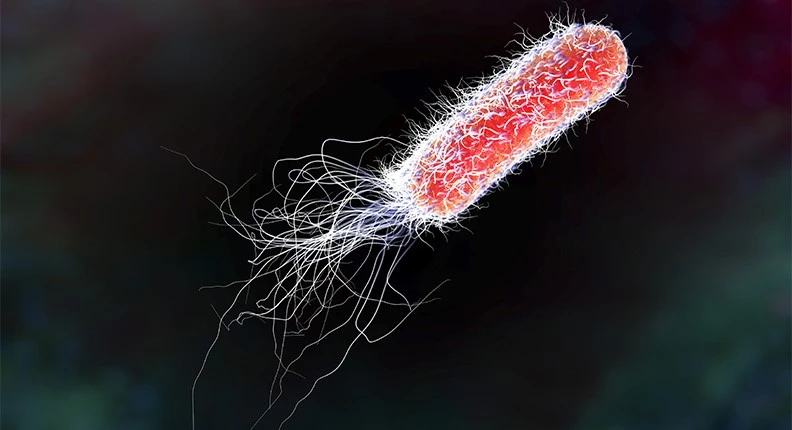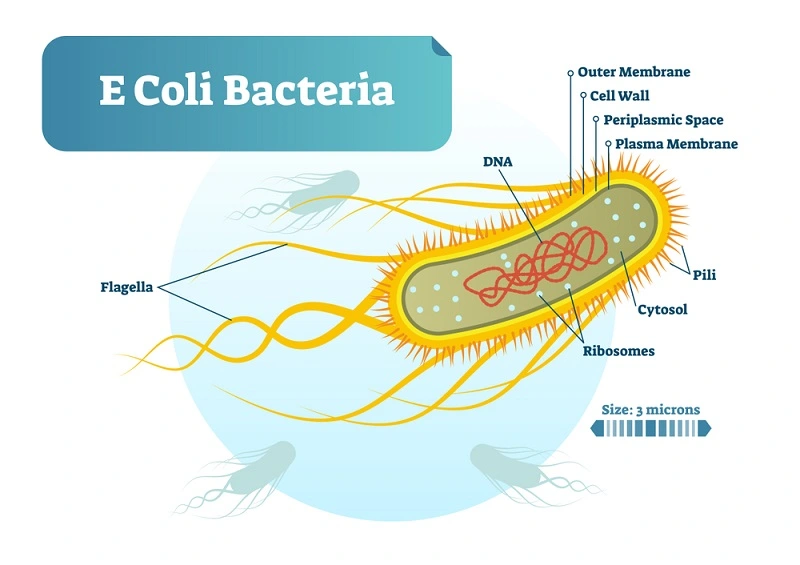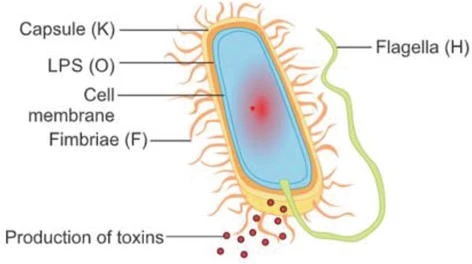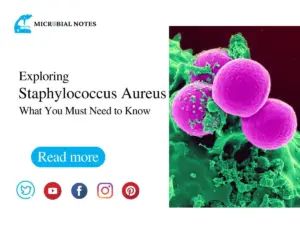Introduction
Escherichia coli, also referred to as E. coli, is an essential bacterium that has significant effects on everyday life and scientific research. This bacterium, which bears the name Escherich after its discoverer, is a vital component of the digestive system in both humans and warm-blooded animals because it helps produce specific vitamins and maintains the general equilibrium of the gut microbiota.
Even though many E. Coli strains are harmless, some variations can cause symptoms ranging from minor infections to serious gastrointestinal problems. The fact that this bacterium is both a beneficial inhabitant of the human intestines and a possible cause of infection emphasizes the intricate relationships between microbes and the human body.
Within the field of molecular biology and genetics, E. Coli has long been used as a model organism. Its straightforward genetic makeup, quick rate of reproduction, and comprehension of its structure make it an ideal subject for scientific study. E. coli has been utilized by scientists to elucidate basic concepts in genetics, DNA replication, and protein synthesis.
Historical Background
Theodor Escherich, a German pediatrician, did revolutionary work in 1885 when he identified and described the bacterium, which sets the stage for the rise of E. coli. It is now possible to comprehend the various functions that various E. Coli strains play in the microbial ecosystem thanks to Escherich’s ground-breaking study.

Scientific Classification (historical)
Historical Taxonomy
Initially classified under the family Enterobacteriaceae, a broad bacterial category.
Taxonomic classification relied on observable traits such as morphology, motility, and sugar fermentation.
Modern Taxonomy
- Genus: Escherichia
- Family: Enterobacteriaceae
- Phylum: Proteobacteria
- Class: Gamma proteobacteria
- Order: Enterobacterales
- Suborder: Enterobacterineae
- Family: Enterobacteriaceae
- Genus: Escherichia
- Species: Numerous species within the genus, with Escherichia coli being the most well-known.
Physiological Characteristics
- Metabolism: Facultative anaerobe, capable of thriving in both aerobic and anaerobic environments.
- Motility: Typically motile, possessing flagella for movement.
- Fermentation: Can ferment sugars to produce various metabolic byproducts.
Morphology and Structure
Detailed Morphological Description
The rod-shaped bacteria Escherichia coli usually has dimensions of 1.1–1.5 micrometers in width and 2–6 micrometers in length. Its gram-negative cell wall is comprised of an inner membrane, periplasmic space, and outer membrane containing LPS. Because of their peritrichous flagella, which aid in motility, the bacteria are frequently motile. E. coli has a single, circular chromosome and has a distinctive look under a light microscope.
A nucleoid that contains genetic material, plasmids, and ribosomes are examples of cytoplasmic structures. On nutrient agar plates, E. Coli colonies are usually white and smooth. This thorough morphological description sheds light on the physical traits that distinguish this particular bacterium.
Also read : Colony morphology
Structural Components
Escherichia coli, or E. coli, demonstrates several structural components that support its morphological form and functionality. These consist of:
CELL WALL:
- Gram-negative E. Coli’s cell wall is made up of an outer membrane around a thin layer of peptidoglycan.
- This outer membrane contains lipopolysaccharides, which are pyrogenic (endotoxins) in nature and thus an important virulence factor of the organism.
FLAGELLA
- The hair-like projections that protrude from the cell surface of E. coli are peritrichous flagella.
- With the help of these flagella, E. coli can travel more easily—either toward nutrients or away from harmful substances.
PILI (FIMBRIAE)
- The bacterial surface has small, hair-like projections called pili (Fimbriae) that help the bacteria stick to surfaces.
- For instance, type 1 pili plays a role in E. Coli’s attachment to host tissues.
CAPSULE
- Some pathogenic strains of Escherichia coli have the ability to generate a capsule, whereas some strains lack one.
- The bacterium can evade the host immune system because of its protective capsules.
CYTOPLASMIC STRUCTURES
- Ribosomes are found in the cytoplasm in which the protein synthesis takes place.
- Furthermore, the nucleoid region of E. coli is also found in the cell cytoplasm and has a single circular chromosome.
Together, all of these structural components are essential for E. Coli’s survival, pathogenicity, and interactions with its surroundings. These interactions include the bacteria’s ability to adhere to surfaces, move towards favorable environments, and escape the host immune system.

Antigenic Structure
Antigens produced by Escherichia coli (E. coli) include the following antigens which are crucial for distinguishing between the various E. coli strains:
H ANTIGENS (FLAGELLAR)
- The flagella, which resemble whip-like appendages and give bacteria their movement, are linked to H antigens.
- The diversity within the species of E. coli is facilitated by the possibility that different strains contain unique H antigens.
O ANTIGENS (SOMATIC OR LIPOPOLYSACCHARIDE)
- The lipopolysaccharide (LPS) layer found in the outer membrane of Gram-negative bacteria, such as Escherichia coli, is composed of O antigens.
- These antigens are essential for the classification of strains according to differences in the LPS structure.
- The O antigens consist of lipid A portion which is toxic (endotoxins) that when released in the host body can induce fever.
K ANTIGENS (CAPSULAR)
- Certain strains of Escherichia coli generate a capsule that is made up of K antigens.
- The protective coverings known as capsules are found outside of the cell wall, and the variety of K antigens helps distinguish various strains of E. coli.
- It also helps the organism to escape the host immune system and attachment to different host cell surfaces.
F ANTIGENS (FIMBRIAL)
- The antigens linked to fimbriae, which are short, hair-like projections on the bacterial surface, are known as F antigens.
- Fimbriae are engaged in activities including biofilm development and host cell attachment, and they play a function in adhesion to surfaces.
The serotyping and classification of E. Coli strains depend on these antigenic structures, which also help to identify certain pathogenic variations and advance our knowledge of the virulence and diversity of the bacterium.

Figure 3 Antigenic structure of E. coli Source: Basavaraju, M., & Gunashree, B. S. (2023).
Genetic Characteristics
Genome Overview
- Structure of the Genome: Escherichia coli’s genome is made up of a single circular DNA molecule.
- Size is usually about 4.6 million base pairs, though it might vary amongst strains.
Gene Content
- Between 4,000 and 5,500 genes that code for RNA molecules, proteins, and functional components are present in E. coli.
- These genes are essential for cellular functions, metabolism, and environmental adaptation.
Plasmids
- Small, circular DNA molecules that are independent of chromosomal DNA are carried by certain strains of Escherichia coli.
- Genes that provide favorable features, such antibiotic resistance or the capacity to metabolize particular substances, are frequently found in plasmids.
Genetic Adaptions and Evolution
Horizontal Gene Transfer
- The ability of Escherichia coli to exchange genetic material with other bacteria through a process known as horizontal gene transfer (conjugation).
- The bacterium becomes more adaptive and acquires new characteristics, such antibiotic resistance, as a result of this process.
Phylogenetic Diversity
- The E. coli species is divided into a number of phylogenetic groups that represent a range of ecological niches and environmental adaptations.
- Both horizontal gene transfer and vertical evolution—inherited traits from a common ancestor—have contributed to this variety.
Evolutionary Pressures
- The presence of antimicrobial agents, host immunological responses, and environmental changes have all influenced the evolution of Escherichia coli.
- Its ability to adapt helps it endure and survive in a variety of ecological settings.
Selective Pressures in Host Environments
- Some E. Coli strains have adapted to thrive in particular host environments, such the human gastrointestinal tract.
- Some examples of adaptations are the capacity to use particular nutrients or avoid host immunological reactions.
Types of Escherichia Coli
Escherichia coli is a species that contains several strains, each with distinctive characteristics. The pathogenic strains of E. coli are:
- Enteropathogenic E. Coli (EPEC)
- Enterohemorrhagic E. Coli (EHEC)
- Enteroaggregative E. coli (EAEC)
- Enterotoxigenic E. Coli (ETEC)
Habitat and Ecology
Humans and other warm-blooded species’ lower intestines are naturally home to Escherichia coli. It is essential to the gut flora, aiding in the process of digestion and absorption of nutrients. Although most strains are not harmful, some may infect other human tissues or contaminate food and water sources.
Pathogenicity and Virulence Factors
Pathogenesis Mechanisms
Different strategies are used by pathogenic strains of Escherichia coli to infect people. Among the important pathogenic mechanisms are:
ADHESION AND COLONIZATION
Pathogenic Escherichia coli have the ability to stick to the surfaces of host cells in the intestines through the use of adhesins and fimbriae. This promotes colonization and inhibits the removal of the bacteria by peristalsis.
TOXIN PRODUCTION
By upsetting the balance of electrolytes, enterotoxigenic E. coli (ETEC) generates toxins that are both heat-labile (LT) and heat-stable (ST), which lead to diarrhea.
Enteropathogenic E. Coli (EPEC) injects effector proteins into host cells, altering their structure and function, through a type III secretion system.
PRODUCTION OF SHIGA TOXINS
Hemolytic uremic syndrome (HUS) and other serious consequences are caused by the production of Shiga toxins by enterohemorrhagic Escherichia coli (EHEC), which includes the notorious O157:H7 strain.
INTESTINAL CELL INVASION
Enteroinvasive E. Coli (EIEC) multiplies and invades intestinal cells, resulting in tissue damage and inflammation.
BIOFILM FORMATION
On abiotic surfaces, certain strains have the ability to develop biofilms, which helps them become resistant to antibiotics and disinfectants.
ANTIMICROBIAL RESISTANCE
Treatment of illnesses may be difficult if pathogenic E. coli carries genes for resistance.
For the purpose of creating preventative and therapeutic measures for E. Coli infections, especially those linked to waterborne and foodborne illnesses, it is essential to comprehend these pathogenic pathways.
Different Strains and Associated Diseases
Escherichia coli is a kind of bacteria that comes in numerous strains, each of which has unique traits and is linked to a range of illnesses. Several noteworthy strains and the illnesses they are linked to include:
GASTROENTERITIS
- Gastroenteritis is an associated disease with enterotoxigenic E. coli (ETEC).
- Enterotoxins produced by ETEC induce gastrointestinal symptoms such as cramping in the abdomen and diarrhea, making it a major cause of traveler’s diarrhea.
PEDIATRIC DIARRHEA
- Pediatric diarrhea is a disease associated with enteropathogenic E. coli (EPEC).
- EPEC is known to induce diarrhea in young children and newborns. It adheres to the intestinal lining and causes the normal functioning of cells to be disrupted.
HEMOLYTIC UREMIC SYNDROME (HUS)
- Hemolytic uremic syndrome (HUS) is associated with diseases with enterohemorrhagic E. coli (EHEC).
- Shiga toxins are produced by EHEC, which includes the infamous O157:H7 serotype. Bloody diarrhea is a common side effect of infections, and in more serious situations, it can develop into HUS, a disorder that can result in renal failure.
PERSISTENT DIARRHEA
- Persistent Diarrhea is an associated disease of enteroaggregative E. Coli (EAEC).
- Prolonged episodes of diarrhea, especially in children, have been linked to EAEC. On intestinal epithelial cells, it creates patterns of aggregative adhesion.
INVASIVE GASTROENTERITIS
- Invasive gastroenteritis is a disease associated with enteroinvasive Escherichia coli (EIEC).
- EIEC can enter intestinal cells and multiply there, resulting in diarrhea that is comparable to Shigella-caused inflammatory diarrhea.
URINARY TRACT INFECTIONS (UTIS)
- Urinary tract infections (UTIs) are associated with Uropathogenic E. Coli (UPEC).
- UPEC, which affects the bladder and urinary system, is a common cause of UTIs. It may adhere to and colonize the urinary epithelium due to its virulence factors.
NEONATAL MENINGITIS
- Neonatal meningitis and sepsis are associated diseases with Neonatal E. Coli (NMEC).
- Severe infections in neonates, especially meningitis and sepsis, are caused by NMEC. It can get past the newborn’s intestinal barrier and into the circulation.
Virulence Factors
E. coli possesses a number of virulence factors that enhance its pathogenicity and capacity to infect people. Among E. Coli’s well-known virulence factors are:
FIMBRIAE
- The bacterial surface has hair-like projections called fimbriae that aid in adhesion to host tissues.
- Fimbriae are essential for the initiation of infections because they encourage E. Coli adhesion to particular host cell receptors, which facilitates colonization.
FLAGELLA:
- The whip-like structures known as flagella facilitate the movement of bacteria.
- Flagella helps some pathogenic E. Coli strains find their way through their hosts’ surroundings to target tissues for colonization.
ENDOTOXINS:
- Also known as lipopolysaccharide, or LPS, is a substance found in the outer membrane of Gram-negative bacteria, such as E. coli.
- The host immune system is powerfully activated by LPS. When taken in excess, it might cause an inflammatory reaction that can result in sepsis and septic shock symptoms.
TYPE III SECRETION SYSTEM (T3SS):
- The Type III Secretion System, or T3SS, is a sophisticated system for secreting proteins.
- Toxins are directly injected into host cells by some pathogenic E. Coli strains using T3SS, which alters cellular processes and encourages bacterial survival.
SHIGA TOXINS:
- Strong cytotoxins are known to be Shiga toxins.
- These toxins, which are produced by enterohemorrhagic E. coli (EHEC), prevent host cells from synthesizing proteins, causing tissue damage and aggravating serious conditions such as hemolytic uremic syndrome (HUS).
HEMOLYSINS:
- Hemolysins are toxins that cause red blood cells to lyse. Some strains of E. Coli produce hemolysins, which aid in the propagation of infection and aid in the death of host cells.
CAPSULE:
- The bacterial cell’s outermost layer of defense is called a capsule.
- By preventing phagocytosis, capsules aid in the evasion of the host immune system and promote the survival and persistence of bacteria.
ADHESINS:
- Adhesins are a class of proteins that facilitate the adhesion of bacteria.
- E. Coli adhesins are essential for attaching to particular host cell receptors and promoting the spread of infection.
Clinical Manifestations and Infections
Gastrointestinal Infections
- Diarrhea
- A common sign of an E. Coli infection is watery or bloody diarrhea.
- Dehydration may result from varying degrees of severity.
- Abdominal Pain
- Cramps and discomfort in the abdomen are common in patients.
- The degree of pain may differ according on how serious the infection is.
- Nausea and Vomiting
- Symptoms such as nausea and vomiting are frequently experienced, especially during the initial phases of an infection.
- Persistent vomiting might make dehydration worse.
Hemolytic Uremic Syndrome (HUS)
- Hemolytic Anemia
- E. Coli infections, particularly those brought on by certain strains such as O157:H7, can cause hemolytic anemia by destroying red blood cells.
- Kidney Damage
- Blood clots that develop in the kidneys’ tiny blood capillaries might result in acute kidney damage (HUS).
- Low Platelet Count
- One of the hallmarks of hemolytic uremic syndrome (HUS) is thrombocytopenia, or low platelet count, which can lead to bleeding issues.
Urinary tract infections (UTIs)
- Painful Urination
- E. coli-caused UTIs can manifest as burning or painful when urinating.
- Frequent urination
- Increasing urgency and frequency of urine are common symptoms.
- Lower Abdominal Pain
- UTIs may be accompanied by lower abdominal pain or discomfort.
Respiratory Infections
- Cough and Shortness of Breath
- Respiratory system infections can cause symptoms like coughing and breathing difficulties.
- Pneumonia
- Severe cases may develop into pneumonia, which manifests with fever and chest pain.
Neonatal Infections
- Sepsis
- E. Coli infections in newborns can cause sepsis, which is characterized by systemic inflammation.
- Feeding Challenges
- Babies with the infection may show low weight gain, lethargy, and feeding difficulties.
- General Symptoms
- General symptoms include fever, malaise and fatigue
- Patients frequently report being generally tired and feeling ill.
Laboratory Diagnosis
Diagnostic Tests and Procedures
Escherichia coli (E. coli) infections are diagnosed using a combination of laboratory testing and clinical evaluation.
- CLINICAL EVALUATION: Comprehensive physical examination and medical history gathering.
- STOOL CULTURE: By isolating and characterizing the bacteria, stool samples are used to identify E. coli.
- MOLECULAR TESTS (PCR): Polymerase Chain Reaction is used to quickly detect E. coli DNA in clinical samples.
- BLOOD TESTS: Determine the extent of the infection and any possible side effects.
- IMAGING STUDIES: Ultrasound, CT, or MRI to assess organ involvement and consequences.
- ANTIMICROBIAL SUSCEPTIBILITY TESTING: Utilizing cultured isolates, this method establishes the best antibiotic for treatment.
- SEROLOGY TESTS: Identify antibodies or the immune system’s reaction to Escherichia coli in blood samples.
Based on the clinical setting and presumed infection source, these diagnostic techniques direct the efficient treatment and management of E. Coli infections.
Identification Techniques
Escherichia coli (E. coli) identification procedures use a variety of laboratory techniques to verify its presence and distinguish it from other microorganisms:
GRAM STAINING:
The initial classification is based on characteristics of the cell wall that are visible under a microscope following the application of the gram staining technique. If E. coli is seen using an oil immersion lens in a light microscope, it usually appears as Gram-negative rods.
MACCONKEY AGAR CULTURE:
- E. coli and other lactose-fermenting bacteria can be isolated and differentiated using selective and differential media.
- E. coli colonies on MacConkey agar typically exhibit a characteristic pink color due to lactose fermentation.
BIOCHEMICAL TESTS:
- These tests determine metabolic characteristics (e.g., Voges-Proskauer, Methyl Red, and Indole).
ANALYTICAL PROFILE INDEX (API) STRIPS:
- Rapid and easy identification of bacteria by biochemical processes.
POLYMERASE CHAIN REACTION:
- PCR is a molecular method for identifying particular E. coli DNA sequences.
SEROLOGICAL TESTS:
- These tests detect antibodies or E. Coli antigens.
SERENY TEST:
- Enteropathogenic E. coli linked to conjunctivitis is identified by the Sereny test.
CELL CULTURE TEST:
- Cell Culturing examines E. Coli’s capacity to enter and multiply within host cells.
Treatment and Drug Resistance
TREATMENT FOR E. COLI INFECTIONS
Supportive care can be used to manage the majority of E. Coli infections, especially those that cause gastrointestinal problems. These infections frequently resolve on their own. This entails drinking plenty of water and, if required, taking over-the-counter anti-diarrheal medications. Nevertheless, serious cases might need medical attention, particularly if they include certain strains.
ANTIBIOTIC TREATMENT
Healthcare professionals may recommend medications such as trimethoprim/sulfamethoxazole, fluoroquinolones, or cephalosporins when antibiotics are deemed necessary. The kind and severity of the infection are two important considerations when selecting an antibiotic.
DRUG RESISTANCE:
There is increasing concern over the growth of antibiotic resistance in E. Coli. Resistance may restrict available treatments and raise the possibility of side effects. Drug resistance must be fought by the careful use of antibiotics, strict adherence to recommended dosages, and public health initiatives. Research and surveillance are being conducted continuously to monitor and treat developing resistance trends.
Prevention and Control Strategies
HYGIENE PRACTISES: To lower the risk of fecal-oral transmission, emphasize the importance of washing your hands properly, especially after using the restroom and before handling food.
HANDLING FOOD SAFELY: To prevent foodborne E. Coli infections, cook meats fully, store food safely, and avoid cross-contamination.
SOURCES OF PURE WATER: Make sure people have access to safe and clean drinking water, particularly in places where E. Coli contamination of the water is common.
PUBLIC AWARENESS: Inform the public about the dangers of E. Coli infections, placing a focus on good hygiene, wholesome eating habits, and being aware of potential sources.
VACCINATION: Investigate and support the creation of vaccines directed against particular strains of E. coli to avoid infections, particularly in populations at risk.
ANTIBIOTIC STEWARDSHIP: To reduce the likelihood that E. coli and other bacteria will develop antibiotic resistance, promote the prudent use of antibiotics.
RESEARCH AND SURVEILLANCE: Establish reliable surveillance methods to keep an eye on E. Coli infections and trends in antibiotic resistance. Undertake investigations to get additional insight into the epidemiology and mechanisms of E. Coli transmission.
WATER AND WASTEWATER MANAGEMENT: Reduce environmental contamination and the risk of waterborne E. Coli infections by implementing efficient water and wastewater treatment techniques.
LIVESTOCK AND AGRICULTURE PRACTICES: Take steps to lessen the presence of E. coli in agricultural environments, such as managing manure well and maintaining cleanliness in animal husbandry.
INTERNATIONAL COLLABORATION: Promote international collaboration in the fight against E. Coli infections, the sharing of best practices, and the joint eradication of antibiotic resistance.
Global Impact and Epidemiology
Worldwide Prevalence and Outbreaks
Escherichia coli, a ubiquitous bacterium, exists in diverse strains with varying pathogenic potentials. Although the majority of strains are harmless, some can lead to infections. E. Coli infections are widespread throughout the world, and outbreaks happen occasionally.
The transmission of the disease through food and water is a major factor in its prevalence. Prominent epidemics, frequently linked to tainted food or water supplies, underscore the possibility of extensive consequences. To address and minimize the global occurrence and effect of E. Coli outbreaks, public health measures, international collaboration, and vigilant surveillance are important.
Environmental and Industrial Applications
E. coli in Biotechnology and Industry
Escherichia coli, or E. coli, is a versatile and well-characterized genetic strain that has become a workhorse in biotechnology and industrial applications. Engineered strains of Escherichia coli have multiple uses.
BIOPRODUCTION:
Using recombinant DNA technology, E. coli is used to manufacture a variety of bioproducts, such as medicinal proteins, enzymes, and biofuels.
PROTEIN EXPRESSION:
E. coli is a favored host for protein production due to its quick growth and capacity to express heterologous proteins, which helps with the creation of industrial enzymes and pharmaceuticals.
GENETIC ENGINEERING PLATFORM:
E. coli’s well-understood genetics make it a perfect platform for genetic modification, allowing for the development of tailored strains with specific characteristics.
RESEARCH TOOL:
In molecular biology and genetics research, Escherichia coli is used as a model organism to shed light on basic biological processes and aid in the creation of novel technologies.
PRODUCTION OF VACCINES:
To produce vaccines and further improve immunization methods, engineered strains of Escherichia coli are employed.
APPLICATIONS IN THE ENVIRONMENT:
Strains of Escherichia coli are used in bioremediation processes to break down contaminants and support the sustainability of the environment.
TOOLS FOR DIAGNOSIS:
Biosensors and diagnostic tests employ modified E. Coli strains to improve the sensitivity and specificity of detection techniques.
Environmental Impact and Uses
BIOREMEDIATION:
Certain strains of Escherichia coli have been genetically modified to aid in the breakdown of environmental pollutants and contaminants, hence aiding in the remediation of soil and water.
INDICATION OF CONTAMINATION:
Some E. Coli strains are utilized to help determine the potential health concerns and water quality by acting as an indication of fecal contamination in water.
WASTEWATER TREATMENT:
E. coli helps break down organic materials and boosts the general effectiveness of treatment systems in wastewater treatment procedures.
NUTRIENT CYCLING:
E. coli takes part in the nutrient cycle in the ecosystem by decomposing organic materials and returning vital nutrients to the environment.
SYMBIOTIC RELATIONSHIPS:
Certain strains of Escherichia coli establish symbiotic relationships with their host organisms, facilitating the absorption of nutrients in the intestines of both humans and animals.
APPLICATIONS IN BIOTECHNOLOGY:
To lessen the environmental impact of conventional manufacturing techniques, biotechnological operations employ engineered E. Coli strains to produce a range of goods, including medicines, enzymes, and biofuels.
COMPOSTING:
Specific strains of E. Coli break down organic matter during the composting process, assisting in the breakdown of waste and the creation of nutrient-rich compost.
References
- Authors. Levinson W, & Chin-Hong P, & Joyce E.A., & Nussbaum J, & Schwartz B(Eds.), (2020). Review of Medical Microbiology & Immunology: A Guide to Clinical Infectious Diseases, 16e. McGraw Hill.
- Basavaraju, M., & Gunashree, B. S. (2023). Escherichia coli: An Overview of Main Characteristics. IntechOpen. doi: 10.5772/intechopen.105508
- Jnani, D., & Ray, S. D. (2024). Escherichia coli. In P. Wexler (Ed.), Encyclopedia of Toxicology (Fourth Edition) (pp. 357-367). Academic Press. https://doi.org/https://doi.org/10.1016/B978-0-12-824315-2.00190-1
- Lim, J. Y., Yoon, J., & Hovde, C. J. (2010). A brief overview of Escherichia coli O157:H7 and its plasmid O157. Journal of microbiology and biotechnology, 20(1), 5–14.
- https://www.mayoclinic.org/diseases-conditions/e-coli/symptoms-causes/syc-20372058







